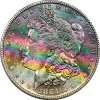tangerinegreen555
Well-Known Member
But it didn't used to be boring, dull and plastered with the same old dead guys.
Just a few generations ago, we had money so artistic, the notes actually came with a title.
The 1896 'Educational Series':

This $1 bill was titled, "History instructing youth". They put the dead president on the reverse, and included the wife for a change. Martha looks like she could be ready to pounce on George later.

This $2 was titled, "Science presents steam and electricity to commerce and manufacture" The famous dead guys were on the reverse again, inventers instead of politicians. How refreshing. The title is on the fine print on the bottom front.

The $5 was titled, "Electricity as the dominant force in the world" These notes were pieces of art and the most collectable of US paper money.
Unfortunately, the fine high society women of Boston freaked out over the partial nudity of the winged woman's breasts and pubic region on the $5. Not to mention her long horn blowing assistant's partially exposed breast to her left. It upset them so much, they went to the towns bank presidents and insisted these vile bills not be allowed in Boston's banks.
Thus the term 'banned in Boston' was born.
The risque educational series was quickly replaced a couple years later will other attractive paper.

Native American tribal chief

Native American majestic beasts

Indigenous birds of prey with wingspans the size of a '56 Cadillac, all far superior in eye appeal to boring modern money.
Even when it started going downhill, it was still interesting because if your town had a bank in the National Bank system, and that bank bought treasury bonds, the government would print money with the bank's name on them in the amount they had invested in bonds. They were delivered in sheets of 4 and were unsigned. The bank president and head cashier had to sign them (they usually had stamps) and hand cut them.

In 1929, they shrunk to current size.
These national banknotes were still in circulation through WWII and beyond and remain highly collectable.


The curious town names add to their collectability. Ever been to Intercourse?
It's fucked up.
Gotta love this old note.

Kind of ordinary, on display at the Smithsonian. Not unique as indicated by serial number, big bank use only when they were printed. $100,000 in 1934 would buy quite a bit. Middle of the Great Depression and all.
Time for something new, tired looking at the same old dead presidents.
Just a few generations ago, we had money so artistic, the notes actually came with a title.
The 1896 'Educational Series':

This $1 bill was titled, "History instructing youth". They put the dead president on the reverse, and included the wife for a change. Martha looks like she could be ready to pounce on George later.

This $2 was titled, "Science presents steam and electricity to commerce and manufacture" The famous dead guys were on the reverse again, inventers instead of politicians. How refreshing. The title is on the fine print on the bottom front.

The $5 was titled, "Electricity as the dominant force in the world" These notes were pieces of art and the most collectable of US paper money.
Unfortunately, the fine high society women of Boston freaked out over the partial nudity of the winged woman's breasts and pubic region on the $5. Not to mention her long horn blowing assistant's partially exposed breast to her left. It upset them so much, they went to the towns bank presidents and insisted these vile bills not be allowed in Boston's banks.
Thus the term 'banned in Boston' was born.
The risque educational series was quickly replaced a couple years later will other attractive paper.

Native American tribal chief

Native American majestic beasts

Indigenous birds of prey with wingspans the size of a '56 Cadillac, all far superior in eye appeal to boring modern money.
Even when it started going downhill, it was still interesting because if your town had a bank in the National Bank system, and that bank bought treasury bonds, the government would print money with the bank's name on them in the amount they had invested in bonds. They were delivered in sheets of 4 and were unsigned. The bank president and head cashier had to sign them (they usually had stamps) and hand cut them.

In 1929, they shrunk to current size.
These national banknotes were still in circulation through WWII and beyond and remain highly collectable.
The curious town names add to their collectability. Ever been to Intercourse?
It's fucked up.
Gotta love this old note.
Kind of ordinary, on display at the Smithsonian. Not unique as indicated by serial number, big bank use only when they were printed. $100,000 in 1934 would buy quite a bit. Middle of the Great Depression and all.
Time for something new, tired looking at the same old dead presidents.












